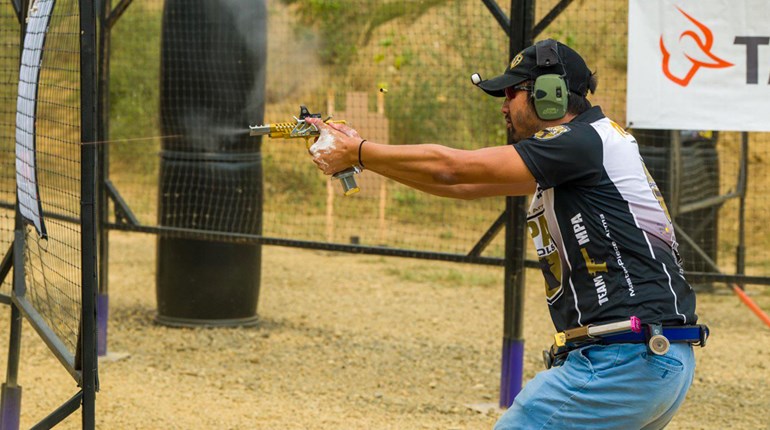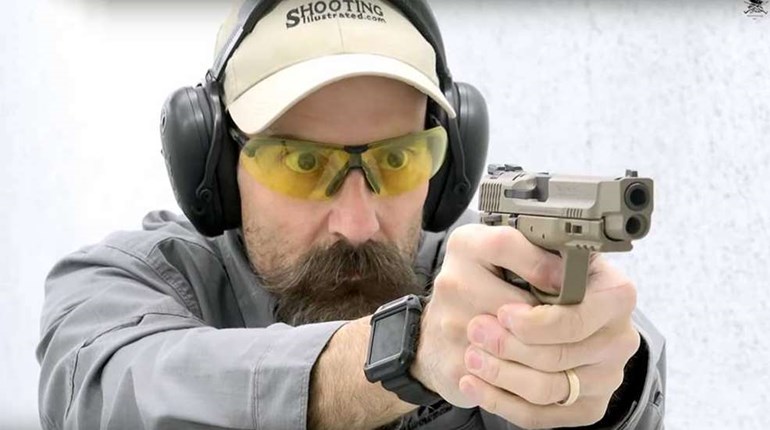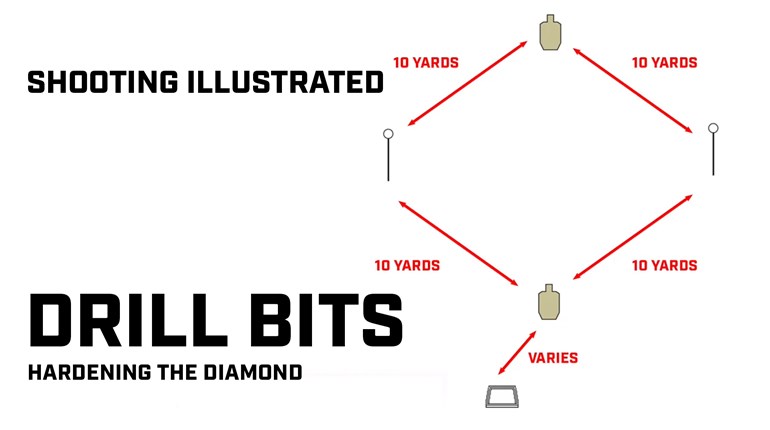
Practical shooting does not lend itself well to casual participation. I think most of us get the “bug” at some point. Heck, I still have the bug and I’m five years into it. I know how it is—we start seeing progress and get hooked. We think about training all day, maybe write journals and logs and train for a long duration. (For me, it can be hours some days.) Dry-fire and shooting in general are a ton of fun, especially as we start to see returns on our investment.
However, with increased enthusiasm and increased training volume, we open ourselves up to potential injury. In practical shooting, the parts of the body that get the most abuse in my opinion are the shoulders, forearms and elbows, and the hands themselves. Hours of dry-fire and live-fire can definitely take their toll on these parts of our body. Between tendonitis, ripped callouses, abrasions and general overuse, our upper body definitely gets its share of the beating. The purpose of this article is to provide insight into how to make our bodies more tolerant of higher levels of training without having to stop actually training to accomplish that. I will share what I’ve learned over the years and how I continue to train more now than ever without having to stop due to injury.
THE MOST COMMON SHOOTING RELATED ISSUE—SHOOTER’S ELBOW
Almost everyone I know that has trained hard in dry-fire and live-fire has ended up encountering this; more commonly called lateral epicondylitis or “tennis elbow,” this is pain on the lateral, or outside portion, of the elbow. This is caused from the repeated gripping that we do in our training on the gun, and as I later learned, from even things like drawing the gun (more on that later). Chances are you feel it when you just move your hands to grip something, and it’s accentuated when you’re holding something with your arm outstretched.
They call this an “overuse” injury, and it is. However, in reading about this, it’s not as much overuse as much as it is “the body isn’t adapted to withstand this volume of activity.” It’s overuse for the current state, but you can (and I have twice) overcome this without having to take time off from training to do it.

My first encounter with this was late 2019. I was putting in a lot of time dry-firing and live firing and sure enough, my forearms were sore. I’m pretty tolerant of pain and I still continued to train as needed, but the pain wasn’t going away after a good night’s sleep. I consider training soreness to be normal—training soreness the day of training that is largely gone by the time you wake up the next morning. You are able to recover from the training and be ready for the next session. However, when the pain lingers on for days and doesn’t really go away, you can be sure that you are starting to creep into that realm of overuse for your current situation.
Fortunately, I had already been somewhat prepared for this situation and had read an article from Chad Reilly of Spinal Flow Yoga about this topic. It is an excellent article with a lot of solid information, and the most important part—how to address the issue. It can be found here. Chad has helped some very well-known shooters with this very issue, namely Rob Leatham and Shannon Smith, and was a competitive shooter himself that has gone through the same issue. He mentions that shooter’s elbow is a self-limiting problem—it will go away with rest, but can take varying amounts of time for it to actually heal. Also, he said in the article that you likely won’t make it any worse by continuing to train as you work through the rehabilitation exercises, and actually recommends dry-firing for 15 minutes a day to keep the tendons used to the stress. He has a simple protocol that he uses as often as the shooter can make time for it, and includes four exercises: Bicep Curls, Reverse Tricep Extension, Forearm Curls and Reverse Forearm Curls.
The protocol was to do three set of increasing weights, provided the user could do 15 reps cleanly with tolerable pain levels. He mentioned that most people feel better as they go heavier, and he was right. I found that as I increased the weight week over week, my pain had significantly gone away. Within a month of three to five times a week in this program, I had noticeably less pain, and it was largely tolerable without reducing my time training. Within three months, my pain was back to basic training soreness which was gone by the next morning. It was reassuring to know that I could overcome this common issue without having to reduce training, and I’m sure if you are a serious competitor or into training to improve, you will be too when this issue eventually comes your way.
For the next few years, I rarely had any issues with my forearms. I strength train three to five times a week normally, and keep myself reasonably strong at all times, along with making intelligent programming decisions that prioritize shooting training, so I didn’t have many issues—that was, until the Eric Grauffel class I took in January 2023.
For one, I got really sick the morning I had to fly to Florida for the course. I had a 6:00 a.m. flight, which meant getting to the airport around 4:00 a.m., and had to wake up at 2:00 a.m.—not the most fun I’ve ever had, and I even had to teach when I got in from the flight. I loaded up on cold and sinus medication, and got my class done and went to the Eric Grauffel class the next day as planned. In that class, we did many draws from the holster, with a 0.6-second par time. While I’m plenty fast with my draws and have spent a lot of time on it over the years, I largely haven’t done that level of volume in a good while. By the end of the day, my right elbow was really sore.
It was worse than the previous bout of it, and I hadn’t been doing the exercises for it since I hadn’t had an issue in a while, so I started doing them again when I got home from the trip. This time, however, they didn’t work. I found myself wondering what happened as the months went by. I tried several things that had worked in the past like forearm extensor training, stretching the forearm for several reps of a minute at a time and—nothing. The pain was there, and it was irritating. I couldn’t draw the gun without feeling a sharp pinch in my forearm.
My fiancee Jeanine and I went on a trip to Texas in April 2023, and I had a scheduled few days of break from training then. My forearm felt better when I got back—yet, I started training, and like the song lyrics “Hello darkness my old friend,” the pain was back again. It was frustrating.

The only time I really noticed a significant improvement was when I would do External Rotation shoulder exercises in my workout program. It was noticeable the day after that I had less pain. Ironically, this would be a part of the key to rehabilitating this injury and I didn’t even know it yet. I could also lift normally without much issue.
This would not be acceptable, so I got in touch with a friend of mine I knew from back in my volleyball days. His name is Terence Crossan and he is a physical therapist at Evolution Physical Therapy in Farmingdale, New York. He was kind and helpful, as he always was, and we set up an appointment for the end of April.
I arrived for my appointment, and Terence went through a bunch of tests, moving my arms in different ways and having me do a bunch of things. We checked out other joints to make sure the issue wasn’t stemming from another part of my body (this is common with injuries for it to begin in a joint that is not the actual one having pain, for instance knee pain starting from an issue with the hip causing you to move in an unnatural way for your body). The conclusion from this testing was that I largely self-diagnosed correctly. He also said I was “strong as all hell” (in different words), and that the issue was presenting itself a bit differently than he would normally see. I had mentioned to him what I had previously done, which he agreed with. He suggested that I may not have done enough volume to solve the issue and gave me a few additional exercises to do. His suspicion was that the way this was presenting (largely pain during the grabbing the gun during the draw) meant two things:
- I had a lot of strength at full extension, but needed to address some strength deficiency at 90 degrees of elbow flexion (bent 90 degrees).
- We may not realize it, but the draw itself is a plyometric action. Plyometrics, by definition are “a form of exercise that involves rapid and repeated stretching and contracting of the muscles, designed to increase strength.” Jumping is a plyometric action and exercise, and puts more stress on the tendons and muscles than just static moving of a weight.
So, when we draw the gun we are snatching a static weight at a very high rate of movement from a largely bent elbow position. This seemed to make sense to the both of us and we came up with a plan.
THE PLAN
Accumulate 10 sets over the course of the week of each exercise, broken into however many days I wanted to do. Work each exercise with a straight arm and at 90 degree bent elbow position if necessary.
THE EXERCISES:
- Forearm Curl—90 degrees bent
- Reverse Forearm Curl—90 degrees bent and straight arm laying across table or bench
- Hammer Wrist rotation Internal (toward body) and External (away from body)
- Hammer Wrist rotation 180 degrees back and forth
- Plyo ball drop and catch at holster position and straight arm
I should add that I made it pretty clear that I wasn’t going to decrease training volume at all, and Terence, being a high-level athlete himself, totally understood and didn’t expect anything less. He was professional and showed a great enthusiasm for trying to figure out an issue that was a bit different than what he was used to. He gave me the guidelines by the green/yellow/red light principles. If I felt a pain around the 5/10 level, I was totally fine to continue training and doing the exercises (green light). If I felt a 6/10, consider modifying them to accommodate and reduce the pain back to at least a 5/10 (yellow light). If we got to a 7/10, we would need to change something before continuing (red light).
I started off with doing these exercises two sets, two times a week, of 15 repetitions each with good form. Within a few weeks, my pain was essentially gone. In addition to this, I actually increased my training volume in dry-fire and live-fire. So this was a win-win for me personally. The main keys were what was described above—doing strengthening exercises at the 90 degree bent elbow position and adding a bit of a plyometric action to each repetition to prepare the muscles and tendons for what was about to happen.
At the time of me writing this (end of September 2023), I have trained seven days a week for at least an hour or more of dry-fire, and have shot quite a few thousand rounds live. I continue to do the exercises for two sets once a week as a maintenance protocol, and have had zero issues with my elbows and forearms since the issue was solved. I suspect I will not have issues for a long time going forward.

I’m thankful for the people that have shared their information with me to help me overcome an issue that can be highly debilitating, and I’m thankful to now be able to share these tips as an opportunity to help the community that I love solve their issues as well.
I’ll include the weights I’m currently using so you have an idea of what I’m at strength-wise. You should start with weights that you can do 15 repetitions in good form, however, and that may be different than what I’m currently using.
- Forearm curl—55 pounds.
- Reverse Forearm curl—22.5 to 25 pounds, both bent and straight.
- Hammer wrist rotation—13.75 to 15 pounds. I use a plate loaded standard dumbbell with the weights on only one side. I hold the threaded end to perform this properly.
- Plyo ball drop and catch—four pounds at holster position and arm straight.
If you start having Shooter’s Elbow, and you don’t suspect anything else is going on, give these a try and see if it helps you. You could also add it into your training regimen as a preventative as well so that you can train hard and not have to worry about it in the first place.
Here’s to a long career of happy and healthy dry-fire and training.
Article from the November/December 2023 issue of USPSA’s magazine. All photos by Rob Epifania.



































